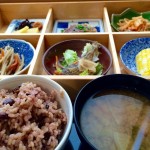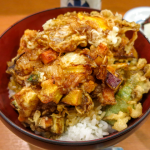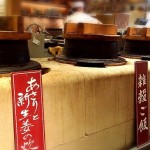Experience the “real” Edo at Edo Tokyo Museum
Hearing the word “museum”, what sort of image comes to your mind? Important documents tucked away in a glass case? Or a “chamber of knowledge” that has come about after years and years of research?
Edo Tokyo Museum has both of these elements, but it is also a place where you can experience the “real” with your own senses. This article will introduce the Edo Zone of the permanent exhibit at this museum.
A journey through space and time beginning from “Nipponboshi” (日本橋), a bridge at the center of Edo
The full scale-model of Nipponbashi, which is at the entrance of the permanent exhibit on the 6th floor, is almost like a symbol of the Edo Tokyo Museum. Once you walk across this bridge, the exhibit begins.
From the Edo Period up until the present day Tokyo, Nipponbashi and the surrounding area are said to be at the heart of the Japanese economy.
While walking across the bridge, take in the view of the exhibits downstairs - you will feel as though you have time travelled back to the Edo Period.
On the left hand side downstairs is a beautiful yose, or a public entertainment hall, in which people of Edo enjoyed rakugo, manzai, music, and so on.

Nipponbashi is said to be first constructed in 1603. It was the starting point of several of the major roads of Edo, such as Tokaido, and the Nipponbashi River running underneath was also pivotal to the water logistics of the Edo Period.
The streets of early Edo Period, lined with about 800 miniature model figures
Once you walk across the bridge, you will be greeted with scenes of a bustling city of the Edo Period. It is a 1/30-scale replica of the merchant district near the area of Nihonbashi Kitazume during the Kanei era (early stages of the Edo Period). You can get a bird’s-eye view of the main street starting from Nipponbashi (today’s Chuo-dori). Various scenes of a bustling day-to-day life in Edo are replicated using the 800 miniature model figures.
The buildings and the figures are all intricate and carefully replicated. A busy-looking street vendor with a carrying pole on his shoulder, the townspeople joyfully watching the street performance, a samurai with a fierce look on his face, or a woman washing her clothes... if you stare at them intently, it will feel as though you too have become a part of this little merchant town. You can also use the binoculars to get a closer look of the carefully created facial expressions on each of the individual figures.
Next to the replica of the merchant town, you can experience riding on the kago (traditional Japanese carriage) of the daimyo (powerful feudal lords), which is another aspect in which this museum makes you feel as though you have time travelled to the Edo Period.
Children and adults alike all want to have a turn, so there is generally a line for this kago experience.
At the Tokyo Edo Museum, there are many exhibits like this one, which you can actually experience yourself.
You will feel tempted to go around the rest of the museum while being luxuriously carried around in the kago, just as the daimyo had in the Edo Period.
The Daimyo Yashiki of imposing presence
After feeling like a daimyo, being carried around in the kago, next up is the Daimyo Yashiki, or a daimyo mansion. There is a replica of the luxurious residence of Matsudaira Iyonokami Tadamasa, who was the feudal lord of Echizen Fukui domain, which was once located in front of the main entrance of the Edo Castle. The mansion has existed during the same period as the previously mentioned merchant town and the scale of the replicas are exactly the same; by comparing the two, you can easily see how massive and magnificent this mansion had been.
The simple life of the working class in nagaya
If you go down to the 5th floor, you can take a peek into the lives of the common people of the Edo Period. Here, there is a full-scale replica of the part of a nagaya, or a tenement house, in which the common people of Edo period lived in. At the time, Edo was overpopulated and the common people lived in small spaces with a minimum amount of household goods. In the townsmen district, which took up less than 20% of the whole of Edo, many of the common people led a simple life with rented housings.
The world of kabuki, enjoyed by the common people as well
There is no explaining the Edo culture without mentioning the world of kabuki. At the time, the common people and the samurai class alike has enjoyed the flamboyant performances in the kabuki theaters. At Edo Tokyo Museum, the world of “Sukeroku” (助六), a famous number of Edo Kabuki, is reenacted with a display of the character costumes.
The highlight is the full-scale replica of the Nakamura-za
Bringing the Edo Zone to the finish is the exhibit of the full-scale replica of the front part of the Nakamura-za, one of the most prestigious kabuki theaters of the Edo Period.
Under the row of paper lanterns is the list of names of famous kabuki actors and above them is the dramatic pictorial billboards. The billboard depicting an arrow piercing the target, in hope that the act will be a “hit”, is also carefully replicated. Such intricate replicas gives off a sense of excitement and it is almost as though you start hearing the lively voices of the crowd eagerly gathering around the theater for the long-awaited performance.
The nostalgic atmosphere of traditional downtown Tokyo lingers in Ryogoku (両国)
In Ryogoku, right near the station is the Kokugikan (国技館), also known as Ryogoku Sumo Hall. The sight of enormous sumo wrestlers riding small bicycles around the area makes you want to chuckle just a bit :) There is a nostalgic feel of downtown Tokyo lingering in the area and it would be a great place to walk around after stopping by the Edo Tokyo Museum. Since Ryogoku is an area that has a historic atmosphere all together, it feels as though the Edo Tokyo Museum fits right in.
The current special exhibition “The Castles of Tokugawa” (徳川の城)
Edo Castle, Nagoya Castle, Sunpu Castle, and Nijyo Castle...
The exhibit gets a close-up look on the castles built by the renowned shogun, Tokugawa Ieyasu.
This special exhibit ends on September 27th(2015), so if you’re interested, make sure you don’t miss it.
writer:yoko



















